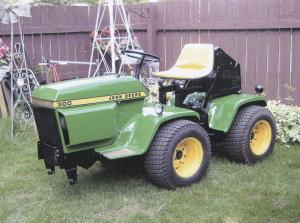2011 - Volume #35, Issue #2, Page #43
[ Sample Stories From This Issue | List of All Stories In This Issue | Print this story
| Read this issue]
4-WD Articulated Deere Garden Tractor
 |
They used most of a Deere 300 model equipped with a 16-hp engine on the front, removing the front axle. The rear end off a 316 model mounts behind it. Both tractors are about 30 years old. The tractor's four wheels are off the original garden tractors, and all of them drive.
After cutting the front axle and wheels out from under the 300 model, they moved its rear end and transmission forward 16 in., which left the tractor's front end hanging out about 2 ft. They cut 38 in. off the front of the 316 model.
The 300 model's driveshaft connects the transmission in front to the 316 transmission in back, with a pair of universal joints in between.
To connect the two drive axles together, they welded a triangle-shaped angle iron plate between them and then added the articulation point. They used swivel ball sockets off a Cat. 2 3-pt. hitch to make the articulation point. "The tractor has a total of three swivel ball sockets, which allow the back tractor to follow the ground contour separate from the front tractor," says Eugene.
Both transmissions are hydrostatically controlled by a lever that mounts next to the steering wheel. A throttle cable extends to the back transmission and is synchronized so that both transmissions pull or are in neutral at the same time.
Steering is controlled by a 6 by 1 1/2-in., double-acting hydraulic cylinder, which swivels on a steel pin that's welded to the tractor's articulation point. "The front tractor's original steering valve control is hooked up to the hydraulic cylinder and is used to control the steering," says Eugene.
"It makes a nice-looking tractor with a lot of traction. If we want, we can mount a snow blade on front and add suitcase weights off a Belarus tractor on back to offset its weight. We painted the unit this summer, adding lights on the fenders. We plan to make a 3-pt. hitch and hook up double-acting control valves under the seat in order to operate it. The 3-pt. could be used to operate a rototiller, mower or snowblower.
"We chose these particular tractor models because both are equipped with the same hydrostatic transmission and have horizontal shafts between the engine and transmission that lined up correctly. It took a long time to find the tractors. All the bolt holes were the same, so we were able to join the tractors together without cutting the hood or side panels.
"We used two universal joints at the articulation point in order to reduce the angle on the driveline and minimize driveline 'chatter,'" notes Eugene.
The front axles removed from the 300 tractor model were used to build a trailer. "We can tow the trailer by hand or, by removing half the hitch, hook it up to the tractor," he says.
The Kabans paid $500 for the 300 model and $550 for the 316. "We spent about $100 to overhaul the 300 model's engine. However, we got some of that money back because we sold the 316's engine for $200," notes Eugene.
Contact: FARM SHOW Followup, Eugene A. Kaban, 702 Ottawa Ave., Brandon, Man., Canada R7A 1N2 (ph 204-726-5882).

Click here to download page story appeared in.

Click here to read entire issue
To read the rest of this story, download this issue below or click here to register with your account number.




